Konquest
Engine
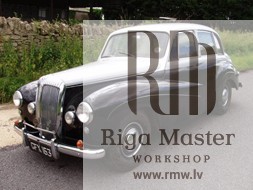 The standard 1953 cast iron, single Zenith carb, 6.6:1 compression, 2.4 L (2433 cc, 148 cu in) 75 bhp (56 kW) Conquest motor was essentially a six cylinder version of the Leda four. Bore was 76.2 mm (3 in) and stroke was 88.9 mm (3.5 in). The 1954 Conquest Century model had a new alloy head with big valves, higher compression, high lift cam, and twin SU carburettors.[2]
The standard 1953 cast iron, single Zenith carb, 6.6:1 compression, 2.4 L (2433 cc, 148 cu in) 75 bhp (56 kW) Conquest motor was essentially a six cylinder version of the Leda four. Bore was 76.2 mm (3 in) and stroke was 88.9 mm (3.5 in). The 1954 Conquest Century model had a new alloy head with big valves, higher compression, high lift cam, and twin SU carburettors.[2]
Body, chassis, and running gear
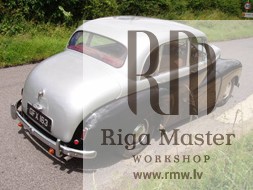 The usual Daimler large cruciform chassis had a double wishbone front suspension, with laminated torsion bars, telescopic dampers and a sway bar, while the rear suspension used leaf springs with telescopic dampers.
The usual Daimler large cruciform chassis had a double wishbone front suspension, with laminated torsion bars, telescopic dampers and a sway bar, while the rear suspension used leaf springs with telescopic dampers.
Automatic chassis lubrication to 21 points, using a pump controlled by exhaust heat, was a Conquest model feature.
Cam and peg steering was used, and Girling hydro-mechanical brakes. (Hydro - mechanical = hydraulic front, mechanical rear brakes.) The cars had an 2642 mm (104 in) wheelbase.[2]
Performance
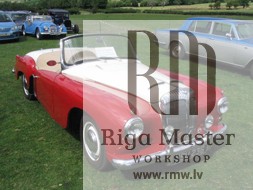 The Conquest motor produced 75 hp (56 kW) at 4000 rpm, and 124 lb•ft (168 N•m) of torque at 2000 rpm. In Century form the dry liner, pushrod engine with its balanced crank and large water jacket, delivered 100 hp (75 kW) at 4000 rpm, and 130 lb•ft (176 N•m) of torque at 2400 rpm. A Daimler four speed preselector gearbox with "fluid flywheel" was used.
The Conquest motor produced 75 hp (56 kW) at 4000 rpm, and 124 lb•ft (168 N•m) of torque at 2000 rpm. In Century form the dry liner, pushrod engine with its balanced crank and large water jacket, delivered 100 hp (75 kW) at 4000 rpm, and 130 lb•ft (176 N•m) of torque at 2400 rpm. A Daimler four speed preselector gearbox with "fluid flywheel" was used.
The Saloon had steel bodies weighing 1,397 kg (3,080 lb) (Conquest: 81 mph (130 km/h), 0-60 mph: 20.4 seconds. Conquest Century: 90 mph (140 km/h)).
The Roadster had an aluminium body, except for the bonnet, and aluminium castings were used instead of a traditional timber frame. (100 mph, 0-60 mph: 14.5 seconds, 25.5 cwt (1300 kg))
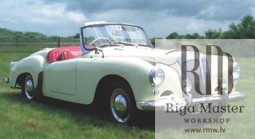 The Drophead had a powered roof folding mechanism, and shared few body parts with the roadster. (87 mph (140 km/h)), 0-60 mph: 16.3 seconds)
The Drophead had a powered roof folding mechanism, and shared few body parts with the roadster. (87 mph (140 km/h)), 0-60 mph: 16.3 seconds)
The New Drophead had steel to the B-pillars, and alloy from there back, apart from steel inner rear guards. (89 mph (143 km/h)), 0-60 mph: 19.7 seconds)
The lighter roadster was slightly taller geared; while the heavier new drophead was slightly lower geared. Other differences to the Conquest saloon include half inch wider brakes, and steering that was 2.5 turns lock to lock instead of 3.25.[2]
A saloon tested by The Motor magazine in 1953 had a top speed of 81.6 mph (131.3 km/h) and could accelerate from 0-60 mph (97 km/h) in 24.3 seconds. A fuel consumption of 20.3 miles per imperial gallon (13.9 L/100 km; 16.9 mpg-US) was recorded. The test car cost £1511 including taxes. [1
Origins
Presented as a new car, the 75 hp (1953 - 1956) Daimler Conquest saloon chassis and running gear had originated in the 1950 Lanchester Fourteen/Leda. Lanchester was owned by the BSA group.(The Conquest's appearance was identical to the Lanchester Leda, apart from the grille. The Leda was made of steel, on a timber frame.)[2]
Production history
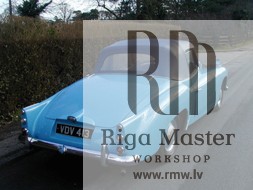 The Conquest saloon was released to the public in 1953 as a replacement for the Daimler Consort, but was shorter and lighter, with better performance. The Daimler Conquest was meant to be an affordable Daimler, priced at 1066 pounds. (That price may well be linked to the name "Conquest".) It was pedigree with pace, at a reasonable price. Mind you, they still had luxurious well appointed traditional wood grain and leather interiors. Actual construction was by another BSA subsidiary, 'Carbodies'.
The Conquest saloon was released to the public in 1953 as a replacement for the Daimler Consort, but was shorter and lighter, with better performance. The Daimler Conquest was meant to be an affordable Daimler, priced at 1066 pounds. (That price may well be linked to the name "Conquest".) It was pedigree with pace, at a reasonable price. Mind you, they still had luxurious well appointed traditional wood grain and leather interiors. Actual construction was by another BSA subsidiary, 'Carbodies'.
The Daimler Conquest Century, released in 1954 was the best seller of the range with 4818 of them produced. A hundred horsepower and, presumably, a hundred miles an hour, hence the Century.
The roadster first appeared at the Motor Show in 1953, and was not available to the public till 1954.
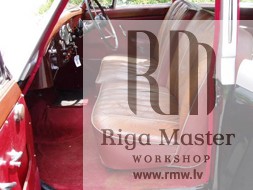 The roadster was dropped from production in 1955, and even though the dropheads had outsold them by over 3:1, the Drophead was axed too (??!!), allowing a new revamped drophead version of the roadster to be produced for the 1955 Motor Show. The New Drophead, or Mark II, had a sideways facing single rear seat.
The roadster was dropped from production in 1955, and even though the dropheads had outsold them by over 3:1, the Drophead was axed too (??!!), allowing a new revamped drophead version of the roadster to be produced for the 1955 Motor Show. The New Drophead, or Mark II, had a sideways facing single rear seat.
Two of the roadsters, at least, were coach-built as fixed head coupes. There is one fibreglass new drophead, and one fibreglass fixed head coupe (with a Hillman Minx Californian three piece rear window!!) One-offs seem to have been mostly done on Roadster allocated chassis, so there may have been even fewer roadsters built than officially indicated.
In 1956 the Daimler Conquest buyers were offered the choice of an automatic transmission or the traditional preselector system. Time was changing gear. Preselector gearboxes faded away as modern automatic transmissions took their place.
The Roadster had started out priced close to the Jaguar XK120 at 1673 pounds, but by the time the New Drophead was released the price was 280 pounds more than an XK140. While Jaguars became less expensive, the hand built Daimlers escalated in price. Jaguars sold in large numbers, and Daimlers sold in small numbers with frequent model changes. The writing was on the wall.[2]
